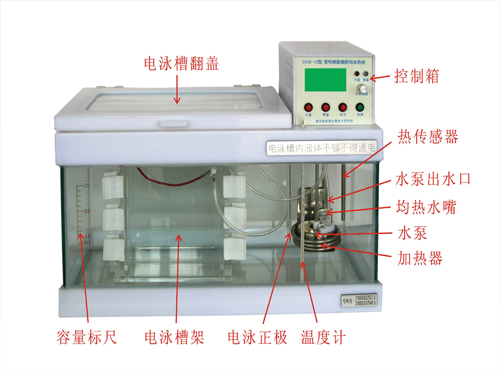
TEL:025-58000618
FAX:025-58000718
Mobile:13912995166
Hotline:400-600-8390
Mail:admin@nj-keyscience.com
American office:
TEL:1-877-660-2333
FAX:1-803-403-8072

 Your current location:Home > Electrophoresis system
Your current location:Home > Electrophoresis system
DGGE denaturing gradient gel electrophoresis system which is our latest patent product (3 patents), consists of a built-in temperature control system, a Chinese programmable power supply, gradient gel generator, built-in buffer circulating pump, mixing paddle, electrophoresis tank, gradient generator system, glass plates. This product has received high praise since it came into market. The current customers include Nanjing Institute of Geography and Limnology Chinese Academy of Sciences, Institute of Geochemistry Chinese Academy of Sciences , Institute of flowers and vegetables Chinese Academy of Agricultural Sciences, the State Oceanic Administration, Northeast Agricultural University, Jiangsu Province Academy of Agricultural Sciences, China Three Gorges University, Jianghan University, Yangzhou University, Jiangsu Science and Technology University, East China Normal University, Yanbian University etc.
DGGE Introduction:
DGGE (denaturing gradient gel electrophoresis) analyzes PCR product. If the mutation occurs in the first melting region of DNA, the detection rate is up to 100%, and the detection fragments is up to 1kb while the optimal range is from 100bp to 500bp. When the double-stranded DNA in the denaturing gradient gel reaches the denaturation temperature of DNA, DNA will partially melt, and electrophoretic mobility rate will drop. When a base in the melted DNA chain changes, it will melt at different time and be separated for affecting the electrophoretic velocity.
Since denaturing gradient gel electrophoresis make use of temperature and gradient gel migration rate for detection, a dedicated electrophoresis device is needed. PCR synthesis preferably pluses 40bp-50bp GC folders at the 5 `end of the period, to facilitate the detection of mutations occurring in high melting point region.
Principle:
The principle is to use a pair of specific primers to make microbial natural populations 16s rRNA gene which is amplified by PCR result in mixture of DNA fragments which are the same length but different sequences. Then DGGE (denaturing gradient gel electrophoresis system) is used to separate the mixture. DGGE gel is made from a 6% polyacrylamide gel in which denaturing agent of linear gradient is added and the concentration of denaturant is regularly becoming higher from top to bottom. Products of different sequence have different melting degree under the same temperature and the same concentration of denaturant. The melting degree of products directly affects its electrophoretic mobility. As a result, different products separate in the gel. If a GC string of about 40 bases is added to the 5end of the primers, the resolution of DGGE for sequence differences is improved up to nearly 100%. Therefore, denaturing gradient gel electrophoresis can be used to study microbial community structure, microbial population dynamics analysis of enrichment cultures and isolates the analysis of ribosomal RNA homology analysis. However, as insertion errors of bases may exist in the PCR amplification process, and different microbial cells breaks differently, there may be some deviation of the final analysis.
Application fields:
DGGE denaturing gradient gel electrophoresis system is mainly applied to diversity analysis of bacteria of environmental samples, archaea, fungi and eukaryotic microbe (soil, water and other samples can directly extract DNA for amplification test), detection of the symbiotic micro-organisms outside or inside animals and plants; food microbiological testing; medical mutation detection, heterozygote detection and so on.
Features:
DGGE gel has concentration gradient of denaturant, can distinguish different DNA fragments according to the annealing temperature of them, and the resolution is up to a base.
DGGE has precise temperature-control system, more repetitive than the average polyacrylamide gel electrophoresis.
DGGE can separate DNAs PCR products of the environmental samples, and then clone and sequence them while average polyacrylamide gel electrophoresis separates fragments merely bases on the length of them.
Almost all the mutations can be detected; there is no need labeling primers.

Mutant molecules can be separated intact from the wild-type molecules for further analysis.
Can detect genetic diversity of influenza virus, analyze genetic map, detect SNP differences of single nucleotide.
Can detect DNA modifications, like methylation.
Experimental process:
DNA samples extraction → PCR Amplification → DGGE Electrophoresis → band type analysis → sequence of the characteristic bands
Technical parameters:
Two program-controllers; the longest controlling time is 24 hours each; the controlling precision is 1 second
Voltage range: 0-200V, accuracy: 0.1%, Current range: 0-150mA, Ripple factor: 0.1%
Microcomputer intelligent control, Chinese liquid crystal display, with alarming devices to prevent over-voltage, over current or overload
Platinum electrode socket safely wrapped inside the cover to prevent accidental contact, reducing the buffer zone evaporate because of high temperature
DGGE:
DGGE1102denaturing gradient gel electrophoresis,DGGE1102
DGGE1104denaturing gradient gel electrophoresis,DGGE1104